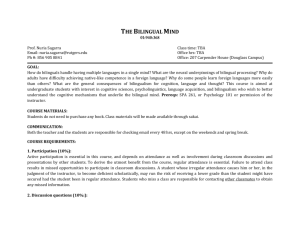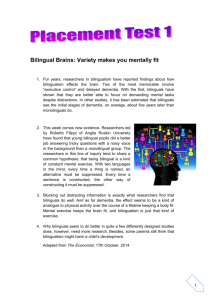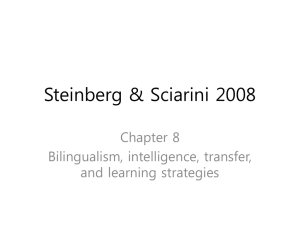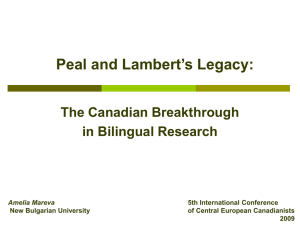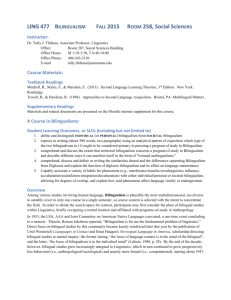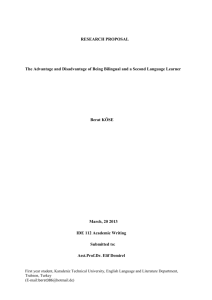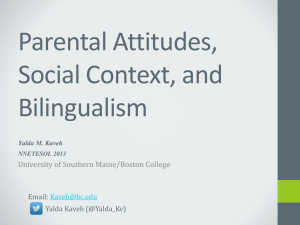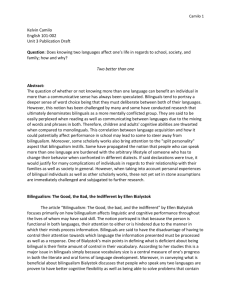Bilingualism, Intelligence & Learning Strategies Presentation
advertisement
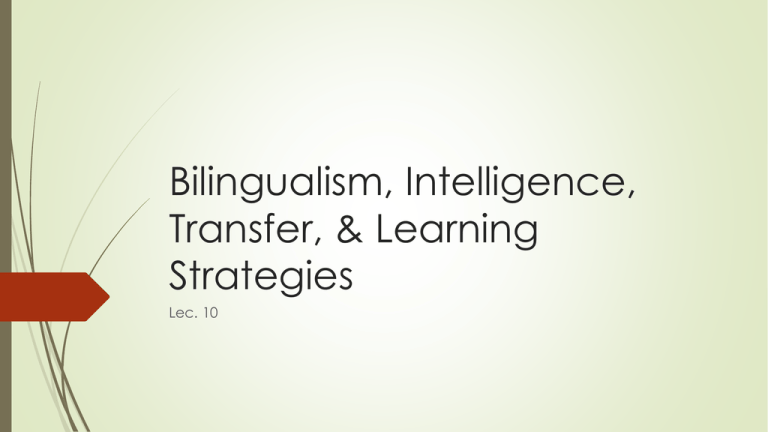
Bilingualism, Intelligence, Transfer, & Learning Strategies Lec. 10 1. Varieties of bilingualism Any two language: speech, sign, or written E.g. sign languages, Sanskrit (written mode), etc. Because language in all its complexity can be acquired through a variety of modalities – sound (speech), sight (writing), and visual motion (signs) – an adequate concept of a bilingual should allow for any of these realizations. 1. Varieties of bilingualism We may say a person is bilingual if he or she knows: 1. Two languages in the same modality, for example, two speech-based languages such as spoken English and Spoken German, or two sign-based languages such as American Sign Language and Japanese Sign Language, or 2. Two language based on different modalities, e.g. spoken German and American Sign Language, or spoken French and written Sanskrit 2. Is bilingualism beneficial or detrimental? Knowledge of another language enables people to communicate with members of other cultures in their own language., which provides a means for further cooperation and understanding among nations and peoples. Knowing another language is also important within countries where there is more than one prevalent or official language, as in Switzerland and Canada. at a personal level, the pleasure and cultural benefits of bilingualism are obvious. 2. Is bilingualism beneficial or detrimental? The arguments offered against bilingualism are typically restricted to young children learning a second language. It must be said that the criticism that has been leveled against early bilingualism is primarily of another era, the early half of the twentieth century. 3. Effects of early bilingualism on firstlanguage development and intelligence I. effects on first-language development Can learning a second language at an early age , while the child is still in the process of learning the native or first language, have a negative effect on the learning of the native language? 3. Effects of early bilingualism on firstlanguage development and intelligence 1. Effects on first language development Negative reports (culturally biased) Smith (1939), Bereiter & Engelman (1966) Positive reports Labov & other researchers (1960s) & (1970s) Bruck et al (1976) Positive effects with very different languages English & Japanese 3. Effects of early bilingualism on firstlanguage development and intelligence 2. Effects on intelligence Negative reports (culturally biased) USA: Goddard (1917) Wales: Saer (1922,1923) Positive reports Peal & Lambert (1962) Bain & YU (1980) 3. Effects of early bilingualism on firstlanguage development and intelligence 3. conclusion It is unlikely that learning a second language negatively affects intelligence in a permanent or important way. In fact, some research suggest there may even be beneficial effects. Given the advantages of knowing another language and of young children’s propensity for speedy language acquisition, there is good reason to favor early bilingualism. 4. Sequential and simultaneous learning situations There are two conditions according to which a person may become bilingual: 1. The two languages can be acquired sequentially, such as the second language being learned later at school (children & adults), or 2. Simultaneously, such as where the young child is exposed to two different languages in the home at the same time (children). 4.1. sequential learning of two languages The difference lies in the starting time In sequential bilingualism, children are said to pass through 4 different stages: 1. Silence 2. Gesture 3. Production of abbreviated utterances 4. Production of grammatical utterances 4.2. Simultaneous learning One person speaks one language ONLY, or one person speaks two languages: 1. One person – One language 1P – 1L 2. One person – Two languages 1P – 2L 4.2. Simultaneous learning The 1P-1L situation is better I simultaneous trilingual case (1P-1L) X 3 Developmental stages in bilingual language learning 4.3. First –language & second-language relations affect learnability: the transfer effect 1. First language similar to second language 2. Facilitation occurs even between very different languages 5. Strategies for second-language production 5.1. the first-language strategy & second –language strategy 1. The first language strategy & the second language strategy i. Errors caused by interference ii. Errors caused by second-language strategy iii. Errors caused by first language strategy 5.2. strategies for sentence production & communication The greater the input, the more the opportunity for language learning Communication strategies 1. Overgvergeneralization 2. Using words form L1 when they are unknown in L2 3. 5.3. strategies for becoming a better second-language learner A person may develop strategies to improve the learning of a second language; such as 1. Verification 2. Inductive processing 3. Deductive reasoning 4. Practice 5. Memorization 6. Monitoring 6. Teaching reading in a bilingual situation at home 1. How to teach the reading of two Language 2. Which language should be read first
